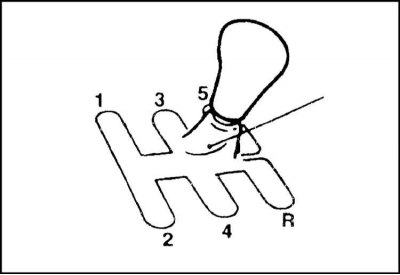Warning! When driving on slippery roads, heavy engine braking or excessive acceleration can cause loss of vehicle control and an accident that could result in serious injury to occupants. Take special care when driving on roads with a surface that does not provide proper traction with the wheels of the car.

The gearshift scheme is shown in the accompanying illustration. To ensure smooth and bumpless shifting, all forward gears are synchronized. On many models, the gearbox has a locking device that prevents direct shifting from fifth gear to reverse gear. When shifting gears "up" (to higher levels) or "down" (to the lower levels) fully disengage the clutch. After moving the gearshift lever to the next gear position, gently release the clutch pedal. While moving the selected gear, completely remove your foot from the clutch pedal to avoid premature wear of the components of the latter mechanism.
Engage reverse gear only after the vehicle has come to a complete stop. Attempting to reverse while moving can cause serious damage to the transmission. Before engaging reverse gear, fully disengage the clutch and hold for a short (in a few seconds) pause.
Note. Instead of a pause, you can make a short inclusion of one of the forward gears. The described techniques for engaging the reverse gear make it possible to prevent shock engagement of the reverse gear due to the residual rotation of the gears.
To slow down the car, you can use engine braking by shifting the gearbox to one of the lower gears. Engine braking allows you to control the speed of the vehicle at a safe level and prevents overheating of the brakes when driving on long descents with a significant incline. Shift the gearbox down sequentially as the speed decreases to prevent exceeding the maximum allowable engine speed on the tachometer. The tachometer needle should not enter the red zone of the scale. In all cases, you should be guided by the values of the maximum permissible vehicle speed in the corresponding gears (see below).
Recommended shift points
Try to move in the highest possible gear that ensures normal operation of the engine with uniform movement and the possibility of smooth acceleration of the car in specific road conditions. Following this recommendation will ensure high vehicle efficiency and efficient operation of the exhaust gas aftertreatment system. When shifting gears, follow the data given in the Specifications.
The maximum allowable vehicle speeds in various gears
The Specifications show the maximum permissible vehicle speeds in various gears. If the specified speed values are exceeded, the tachometer needle will enter the red zone of the scale, indicating an unacceptably high engine speed. At the same time, the electronic unit of the engine control system begins to limit the speed of the crankshaft, reducing the fuel supply, which can be felt by changing the engine operating mode. Engine operation is normalized as soon as the tachometer needle leaves the red zone of the scale.
To avoid engine damage, before changing gear, make sure that the tachometer needle does not exceed the maximum allowable speed in this gear and is not in the red zone of the scale.
